29 Purple Flowering Trees (With Pictures): Identification Guide

Trees with purple flowers are an ideal way to add a touch of elegance and beauty to your garden landscape. Purple flowering trees can enhance the visual appeal of your front or backyard. For example, small ornamental trees with purple flowers don’t take up much room, which is ideal for compact yards. Large purple-blooming shade trees are perfect for shading a patio, deck, or lawn in the summer.
The best purple flowering trees are magnolias, redbuds, mountain laurels, and chaste trees. Many of these small purple-flowering trees are versatile landscaping plants that can grow as multi-stemmed shrubs. In addition to beautiful purple flowers, many trees have lush summer foliage that turns orange, yellow, purple, and red shades in the fall.
This article is an identification guide to purple flowering trees. Descriptions and pictures of different types of trees with purple blooms will help you recognize and choose the best purple flowering trees to enhance your garden or landscape.
Purple Flowering Trees (With Pictures): Identification Guide
Jacaranda Tree (Jacaranda mimosifolia)
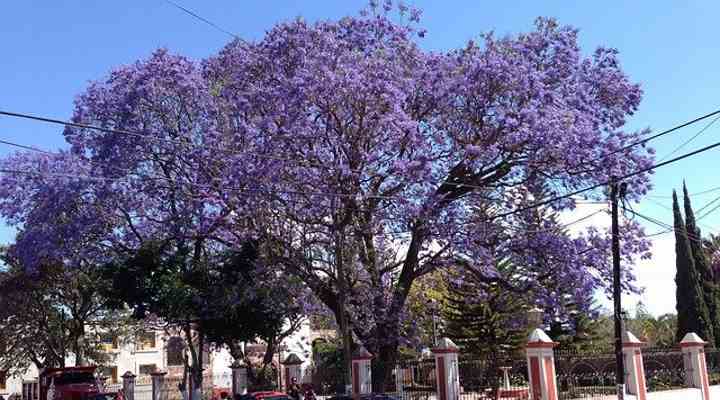
The jacaranda tree is a stunning ornamental tree known for its vibrant clusters of purple-blue flowers. The trumpet-shaped flowers cover the tree in a beautiful floral display during spring and early summer. These blue-violet flowers cover the tree’s wide, spreading, umbrella-like canopy. The flowers are followed by ornamental flattened mahogany seed pods.
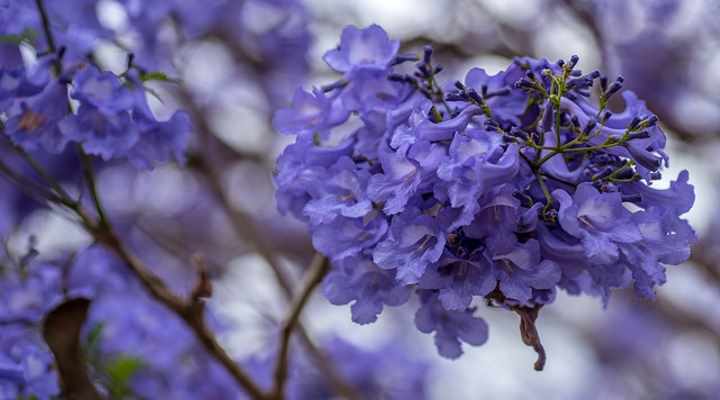
A close up picture of jacaranda tree flowers
The tree’s fern-like leaves are a bright green color and provide a lovely backdrop to the colorful flowers. The purple-flowering trees can be evergreen, semi-evergreen, or deciduous, depending on the climate. Jacaranda trees thrive in warm, tropical climates and prefer well-drained soil.
Jacaranda trees make attractive ornamental shade trees due to their striking beauty. Or you can grow them as a focal point in a garden landscape. The tree’s delicate flowers and graceful form make it popular in gardens and parks.
Mature Size: 25 to 50 ft. (7.5 – 15 m) tall and 15 to 30 ft. (4.5 – 9 m) wide
USDA Hardiness Zones: 10 and 11
Sun: Full sun
Chaste Tree (Vitex agnus-castus)
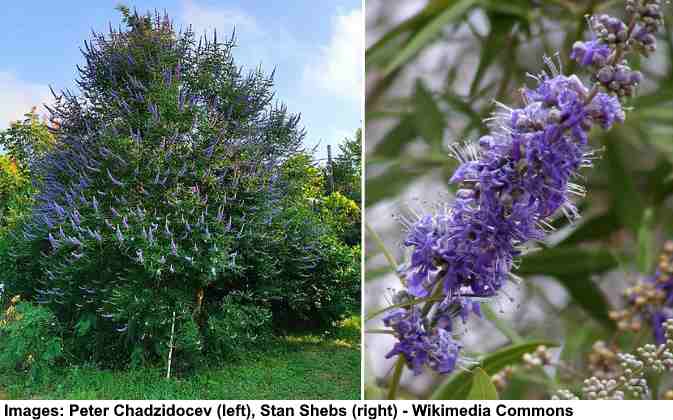
The chaste tree is a small tree or shrub prized for its attractive spiked clusters creating spectacular sprays of fragrant purple flowers. The lilac or pale blue flowers bloom throughout summer, covering the small tree’s vase-shaped canopy. These are followed by small round black fruits that resemble peppercorns.
The tree is also called the monk’s pepper or lilac chaste tree.
Leaves on the chaste tree are aromatic, dark green palmate leaves, giving it a tropical appearance. Five to seven leaflets grow per leaf, with silvery undersides, creating a shimmering appearance in the wind. The dense foliage and long blooming season give the small ornamental tree plenty of landscape appeal.
Chaste trees are ideal for growing as shrub borders, foundation plantings, or specimen trees. They are drought-tolerant once established and are resistant to most pests and diseases. The fragrant purple flowers attract butterflies and pollinators in summer.
Mature Size: 4 to 15 ft. (1.2 – 4.5 m) tall and wide
USDA Hardiness Zones: 6 to 9
Sun: Full sun
Texas Mountain Laurel Tree (Sophora secundiflora)

Texas mountain laurel is a small evergreen tree known for its clusters of fragrant pale purple flowers. The fragrant flowers resemble grape hyacinths and bloom in late winter or early spring. These purple-lavender flowers grow in drooping, showy clusters measuring 3” to 7” (7.5 – 18 cm) long and attract bees and butterflies.
Native to North America, Texas mountain laurel tree leaves are leathery, dark green. The palmate leaves with oval leaflets create dense foliage, adding to the tree’s year-round beauty. Texas mountain laurel trees are drought-tolerant and prefer well-drained soils.
The small purple-flowering tree performs exceedingly well as an ornamental tree in xeriscape gardens or a focal point in small landscapes. The tree’s beautiful flowers and evergreen foliage make it an attractive addition to any garden.
Mature Size: 10 to 15 ft. (3 – 4.5 m) tall and 8 to 15 ft. (2.5 – 4.5 m) wide
USDA Hardiness Zones: 7 to 11
Sun: Full sun to partial shade
Texas Redbud Tree (Cercis canadensis var. texensis)

The Texas redbud tree is a small ornamental tree prized for its showy clusters of magenta-purple flowers. The purple-flowering redbud pea-like flowers burst into color in early spring, covering bare branches before the leaves emerge. The attractive dark pink-purple flowers continue to bloom as the leaves develop.
Purple flowering Texas redbud trees are easy to identify due to their heart-shaped leaves and masses of purple, pink, or deep reddish-purple flowers. Its dark green foliage turns yellow in the fall. Texas redbud trees are adaptable and can grow in a variety of soil types, including clay, loam, and sandy soils.
This variety of redbud tree – native to Texas – performs well in small to medium-sized landscapes. You can grow the Texas redbud as an ornamental tree to brighten an urban garden or create a flowering border. Its vibrant flowers provide a burst of early spring color.
Mature Size: 12 to 18 ft. (3.6 – 5.5 m) tall and 10 to 15 ft. (3 – 4.5 m) wide
USDA Hardiness Zones: 6 to 9
Sun: Full sun or partial shade
Eastern Redbud ‘Forest Pansy’ (Cercis canadensis ‘Forest Pansy’)

The eastern redbud ‘Forest Pansy’ is a small deciduous tree with clusters of showy pinkish-purple flowers. Like all redbuds, this striking cultivar blooms in early spring with abundant pea-sized flowers on bare branches. The cheerful purplish flowers bloom for several weeks, attracting butterflies, bees, and other pollinators.
Purple flowering ‘Forest Pansy’ redbud cultivar is identified by its colorful heart-shaped leaves. These emerge in late spring and are shades of orange, red, red-purple, and bronze. The attractive appeal of the eastern redbud in a landscape is its purple flowers, vibrant red leaves, and flat-topped vase-shaped canopy.
The ‘Forest Pansy’ variety of Eastern Redbud is a popular choice for adding color and year-round interest to landscapes. You can plant it as a specimen tree or help shade a patio or decking area. It’s also well-suited for small gardens or urban environments to add vibrant foliage and purple colors in early spring.
Mature Size: 20 to 30 ft. (6 – 9 m) tall and 25 to 35 ft. (7.5 – 10.5 m) wide
USDA Hardiness Zones: 5 to 9
Sun: Full sun to partial shade
Western Redbud (Cercis occidentalis)
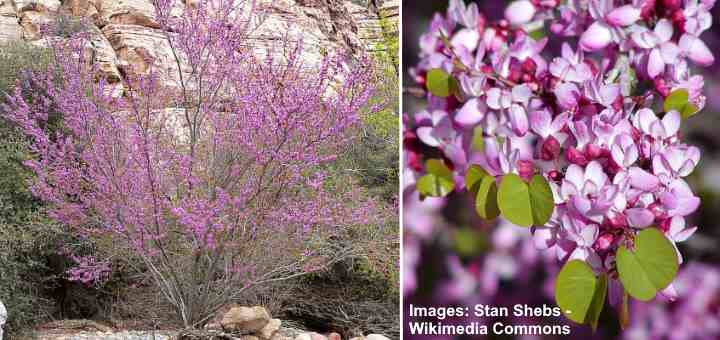
The western redbud is a small decorative tree known for stunning displays of pink-purple flowers. The pea-like flowers burst into color in spring, growing in dense clusters along bare branches. After the bright lavender-purple flowers fade, heart-shaped green leaves emerge. Its ornamental value in the fall is its long, dangling seed pods and rust-red or golden-yellow leaves.
Native to California and the western United States, the Western redbud is well-suited to dry, rocky soils and xeric landscapes. It is drought-tolerant and can withstand hot and dry conditions once established. The tree’s compact size and attractive flowers make it a popular choice for small gardens or as a focal point in a landscape.
The Western redbud grows easily in clay and alkaline soils with excellent drainage. The best blooming occurs when redbuds get six to eight hours of sunlight daily. The proliferation of vibrant flowers attracts pollinators, such as bees and butterflies. The small tree is ideal for butterfly gardens or wildlife-friendly landscapes.
Mature Size: 10 to 15 ft. (3 – 4.5 m) tall and wide
USDA Hardiness Zones: 6 to 9
Sun: Full sun or light shade
Purple Glory Tree (Tibouchina granulosa)
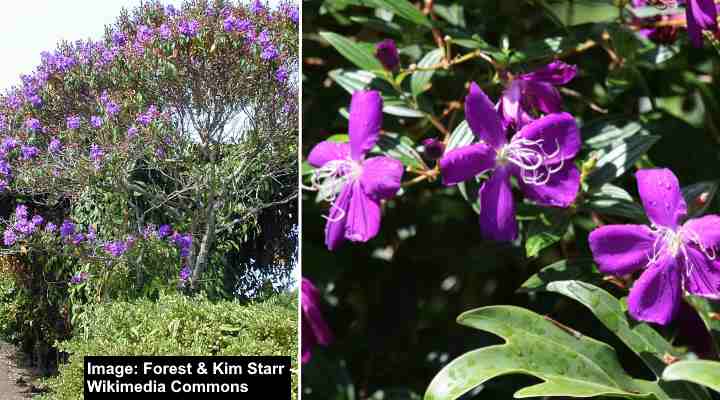
The purple glory tree is a tropical, ornamental bushy tree known for its attractive five-petalled violet-purple flowers. The stunning purple flowers cover the tree’s canopy, creating a vibrant, colorful display throughout the year. The large, velvety flowers contrast nicely with the glossy, dark green lanceolate leaves. Its exotic purple flowers add a tropical touch to landscapes.
The purple glory tree is best suited for warm, tropical climates. It thrives in moist, organically fertile, well-drained soil. However, it needs some shade from the afternoon sun in the hottest regions of its growing zone.
The purple glory tree is highly adaptable in warm landscapes. You can grow it as a specimen tree or an espalier against a wall. Alternatively, the purple-flowering shrub-like tree can grow as a vine over a trellis or arbor. Its versatility makes it ideal for use in mixed shrub borders or containers.
Mature Size: 15 to 20 ft. (4.5 – 6 m) tall and wide
USDA Hardiness Zones: 10 and 11
Sun: Full sun to partial shade
Princess Flower Tree (Tibouchina urvilleana)
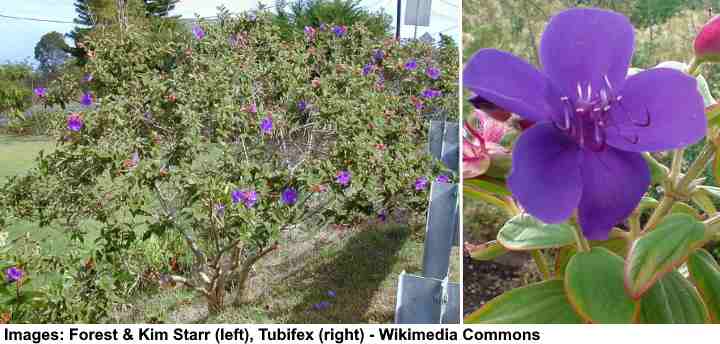
The princess flower is a tropical evergreen shrub or small tree that produces stunning purple flowers. The large, velvety blooms are a vibrant shade of purple. Each attractive flower has five royal purple petals. The flowers cover the plant from late summer to early fall, creating a show-stopping display of color.
The princess flower has dark green, glossy leaves with prominent longitudinal veins. The lush green foliage provides an attractive contrast to the vibrant purple flowers with their wiry stamens.
Grown as a small tree, the purple-flowering princess flower tree is a stunning specimen plant to grow near a patio or lawn for a pop of dynamic color. As a shrub, you can grow princess flower trees to create borders, edging, container planting, foundation planting, or attracting butterflies.
Mature Size: 10 to 20 ft. (3 – 6 m) tall and 6 to 10 ft. (1.8 – 3 m) wide
USDA Hardiness Zones: 9 to 11
Sun: Full sun to partial shade
Purple Orchid Tree (Bauhinia purpurea)

The purple orchid tree is a fast-growing tropical tree known for its stunning purple orchid-like flowers. The vibrant, five-petaled bright purple or pink flowers bloom in large clusters. The purple orchid tree’s bloom time is from September through November, when it adds stunning colors to fall landscapes in the deep South.
The tree’s unusual two-lobed leaves resemble butterfly wings or hearts. The glossy green foliage covers gracefully arching branches. Another attractive feature of the deciduous, purple orchid tree is its 12” long, slender, flattened seed pods that persist through winter.
Purple orchid trees are ideal as ornamental shade trees in gardens and parks due to their striking beauty. Its moderately compact growth makes it ideal as a patio tree in a southern landscape. The orchid tree’s attractive flowers and unique leaves make it a popular choice for adding a touch of tropical beauty to any landscape.
Mature Size: 30 to 35 ft. (9 – 10 m) tall and wide
USDA Hardiness Zones: 10 and 11
Sun: Full sun and well-drained soil
Susan Magnolia (Magnolia Susan)
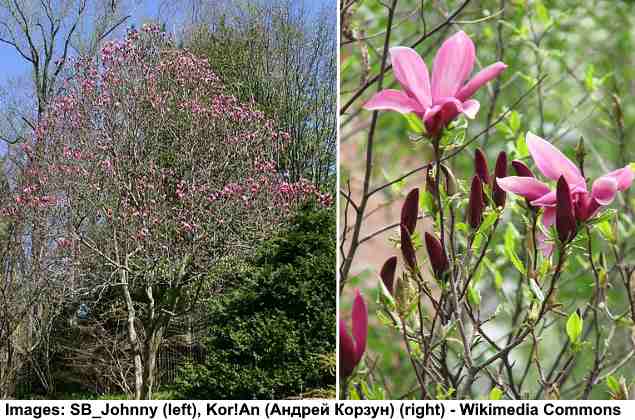
The Susan Magnolia is a stunning purple-flowering small tree with exotic spring blooms. The tulip-like purple-pink fragrant flowers may continue blooming sporadically through summer. Susan magnolia cup-shaped flowers contain six twisted petals and measure 5” (13 cm). They are dark purple on the outside and paler inside.
The magnolia’s dark green, ovate leaves provide an attractive backdrop to the colorful flowers. In the fall, the leaves turn a lovely shade of yellow before dropping. Thanks to its compactness, Susan Magnolia is suitable for small gardens, city gardens, or as a focal point in a landscape.
The Susan Magnolia tree is low maintenance and tolerates various soil types. It prefers well-drained, organically rich soil. For the best results, keep the tree sheltered from cold winds.
Mature Size: 8 to 12 ft. (2.4 – 3.6 m) tall and wide
USDA Hardiness Zones: 3 to 8
Sun: Full sun to partial shade
Saucer Magnolia (Magnolia soulangeana)

The saucer magnolia is an easy-to-grow deciduous tree known for its masses of showy, pink-purple flowers. The large cup-shaped flowers measure 10” (25 cm) across and have upward-facing oval petals. The attractive magnolia flowers have pale pink insides and purple outsides, creating a bi-color effect.
The saucer magnolia obovate leaves appear after the flowers bloom in early to mid-spring. Their glossy texture contrasts nicely with the colorful flowers. The leaves turn yellow or golden brown in the fall, revealing a smooth, silvery bark. The saucer magnolia’s flowers are fragrant and attract pollinators like bees and butterflies.
Saucer magnolia trees are some of the most popular ornamental trees in temperate landscapes. Their spring blossoms add color to city gardens, cottage gardens, or as a standalone specimen tree. They also work well as focal points in landscapes. Saucer magnolias prefer well-drained soil and thrive in various soil types.
Mature Size: 15 to 20 ft. (4.5 – 6 m) tall and wide
USDA Hardiness Zones: 6 to 9
Sun: Full sun to partial shade
Black Lily Magnolia (Magnolia liliiflora ‘Nigra’)

Black lily magnolia is a deciduous flowering tree identified by its stunning rich, magenta-dark purple flowers. When blooming in late spring, the tulip-shaped magnolia flowers are deep purple, and look dramatic on the tree’s bare branches. The flowers have a pleasant fragrance and attract butterflies and other pollinators.
The tree’s foliage consists of large, glossy green leaves, and its fall foliage color is an eye-catching yellow or bronze. Its ornamental features include grayish-brown smooth bark, bushy compact growth, and velvety purple-red flowers.
The lily magnolia’s dwarf size and rounded form make it suitable for small gardens as a specimen plant. Additionally, it’s perfect for planting in a tight corner or where space is limited in a city garden.
Mature Size: 8 to 12 ft. (2.4 – 3.6 m) tall and wide
USDA Hardiness Zones: 5 to 9
Sun: Full sun to partial shade
Purple Flowering Dogwood (Cornus florida ‘Purple Glory’)
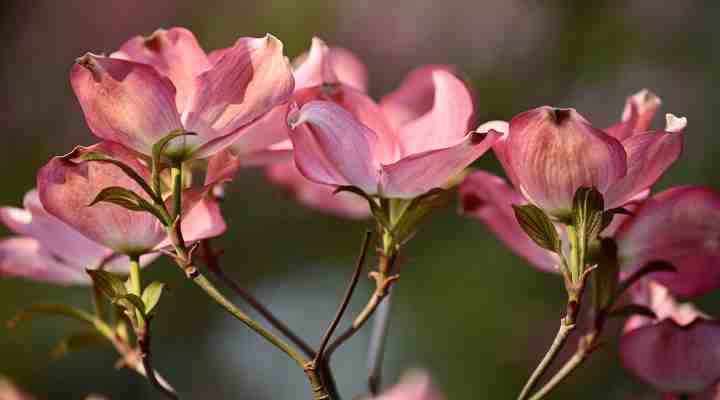
The purple flowering dogwood is a stunning small tree prized for its vibrant purple flowers. The dogwood’s flowers are colorful petal-like reddish-purple bracts that emerge in spring. The ‘Purple Glory’ cultivar has stunning dark purple leaves, giving it tremendous ornamental value. Its fall foliage color is black-purple.
The purple flowering dogwood is fast-growing and has a compact size with a rounded canopy. Even growing in full sun, the tree retains its deep, dramatic colors until the leaves drop in autumn. Purple-flowering dogwoods are popular in small gardens or near lawns or patios. You can also plant it as an accent tree in larger landscapes.
This variety of flowering dogwood is adaptable to various soil types, including clay, loam, and sandy soils. The tree thrives in well-drained soil and partial shade, although it can tolerate full sun with adequate moisture.
Mature Size: 15 to 20 ft. (4.5 – 6 m) tall and wide
USDA Hardiness Zones: 5 to 9
Sun: Partial shade
Common Lilac (Syringa vulgaris)
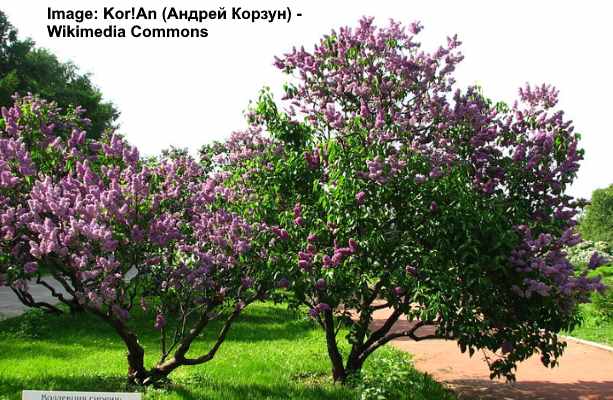
The common lilac is a purple-flowering shrub that can be shaped into a small tree. It has bushy growth and features highly fragrant, cone-shaped clusters of purple flowers on its arching branches. The flowers bloom in late spring to early summer, covering the shrub in a beautiful display of lilac colors and floral scents. The lilac tree flowers can also come in shades of white, pink, and blue.

Common lilac tree leaves are heart-shaped and dark green to blue-green. The attractive foliage is dense, meaning the shrub-like tree performs well as a hedge, privacy screen, or specimen tree. You can grow dwarf varieties in containers to decorate a deck, patio, or entranceway. Common lilacs are cold-hardy and can withstand harsh winters.
Common lilacs are popular ornamental plants due to their low maintenance, tolerance to drought, and reliable spring flowers. Additionally, the fragrant flowers attract butterflies and bees, making it a favorite among pollinators.
Mature Size: 8 to 10 ft. (2.4 – 3 m) tall and 5 to 6 ft. (1.5 – 1.8 m) wide
USDA Hardiness Zones: 3 to 8
Sun: Full sun for best flowering
Purple Flowering Hibiscus Tree (Hibiscus syriacus ‘Purple Satin’ and ‘Azurri Blue Satin’)
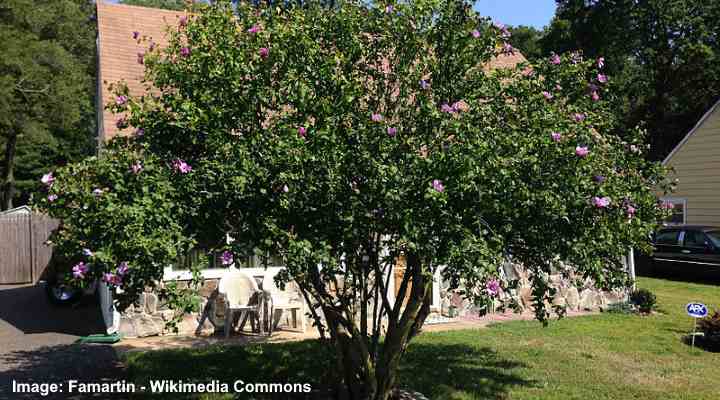
Known as the Rose of Sharon, Hibiscus syriacus is a flowering shrub you can grow as a small decorative tree. Several species of hibiscus have eye-catching showy flowers. The large colorful blooms are typically trumpet-shaped with ruffled petals and have a prominent conical stamen.
Rose of Sharon plants with purple flowers typically grow 8 to 10 ft. (2.4 – 3 m) tall and up to 10 ft. (3 m) wide. Here are short descriptions of three hibiscus trees with purple blooms.
Hibiscus syriacus ‘Purple Satin’: This flowering hibiscus plant has deep purple, single flowers in a funnel shape. The purple hibiscus flowers bloom continuously from summer through fall. It’s ideal for foundation plantings, flowering hedges, or privacy screens.
Hibiscus syriacus ‘Azurri Blue Satin’: The Rose of Sharon purple flowers are large, funnel-shaped flowers with striking pale purple ruffled petals. It’s a perfect flowering shrub or small tree for back-of-the-border planting.

Hibiscus syriacus ‘First Editions French Cabaret Purple’: The spectacular double purple flowers look like carnations (Dianthus caryophyllus). This multi-stemmed shrub is ideal for planting along a foundation line, grouping to create a hedge, or planting in shrub borders.
Purple Robe Locust tree (Robinia pseudoacacia ‘Purple Robe’)

The ‘Purple Robe’ locust tree is known for its dangling clusters of fragrant, pea-like violet-purple flowers. The flowers bloom in late spring, covering the tree in a stunning display of purple shades. The fragrant flowers look like wisteria flowers hanging from upright branches. Long, flattened bean-like seed pods follow the flowers.
The locust tree’s delicate, fern-like leaves emerge bronze-red before turning vibrant green. The pinnate leaves with lanceolate leaflets provide a lovely backdrop to the vibrant pale purple flowers. In the fall, the foliage turns a dull yellow color. A unique feature of the tree is its thorny stems and branches.
The ‘Purple Robe’ locust tree is a fast-growing, hardy tree tolerant of a wide range of soil conditions. You can plant the ornamental tree as a shade tree or specimen tree in a medium-sized garden landscape. Additionally, the vibrant purple flowers attract bees and butterflies.
Mature Height: 30 to 40 ft. (9 – 12 m) tall and 20 to 30 ft. (6 – 9 m) wide
USDA Hardiness Zones: 4 to 8
Sun: Full sun to light shade
‘Royal Purple’ Smoke Tree (Cotinus coggygria ‘Royal Purple’)

The ‘Royal Purple’ smoke tree is a large shrub or small multi-stemmed tree with plumes of pinkish-purple flowers. The identifying feature of the smoke tree is its soft, fuzzy plumes that give the tree a billowing ‘smoky’ appearance. These resemble puffs of pink, purple, or white smoke. These wispy flowers bloom in late spring or early summer, covering the tree in a stunning display.
The smoke tree’s foliage consists of purple, oval-shaped leaves that become deep wine purple in the summer. In the fall, the leaves turn an intense red. The smoke tree has tremendous visual appeal in the landscape thanks to its dark foliage and smoky puff-like flowers.
Smoke trees make excellent landscaping plants due to their unique flowers and foliage. You can also grow them as border plants, informal hedges, privacy screens, or foundation plantings.
Mature Size: 10 to 15 ft. (3 – 4.5 m) tall and 15 to 20 ft. (4.5 – 6 m) wide
USDA Hardiness Zones: 4 to 9
Sun: Full sun to partial shade
Burgundy Desert Willow (Chilopsis linearis ‘Burgundy’)

The burgundy desert willow is identified by its burgundy-pink to purple trumpet-shaped flowers. Blooming in late spring and early summer, the showy funnel flowers cover the tree with vibrant color. Additionally, the nectar-rich flowers attract hummingbirds and butterflies, adding to the tree’s appeal.
The burgundy desert willow has long, slender willow-like leaves. The airy foliage and purplish-pink tubular flowers create a visually attractive display in sunny landscapes. Additionally, you can plant the purple-flowering tree in xeriscape gardens, desert gardens, wildlife gardens as an accent tree, or for erosion control.
The burgundy desert willow tree has a unique color and is tolerant to drought, heat, and day-long sunshine. It’s also resistant to most pests and diseases, making it low-maintenance.
Mature Size: 15 to 20 ft. (4.5 – 6 m) tall and wide
USDA Hardiness Zones: 7 to 9
Sun: Full sun
Purple Flowering Crape Myrtle (Lagerstroemia)

The purple flowering crape myrtle is a stunning small to medium-sized ornamental shrub-like tree. Crape myrtle trees are known for abundant clusters of vibrant purple flowers consisting of crinkly petals. Showy clusters of flowers bloom throughout summer and continue into early fall. Purple-flowering crape myrtle plants bloom in shades of purple, from deep violet to lavender and pale blue.
In addition to their captivating purple flowers, crape myrtle trees have other ornamental attributes. These include smooth, peeling bark and thick, leathery oval leaves that contribute to the tree’s visual appeal and texture. During the summer, the foliage boasts a glossy, dark green color, which later transitions to vibrant shades of orange, red, or yellow in the autumn, enhancing the tree’s overall charm.
Crape myrtles are drought-tolerant and can tolerate a wide range of soil conditions.
Here are several varieties of crape myrtle plants that have purple flowers:
Lagerstroemia’ Purple Magic’: This stunning crape myrtle cultivar is known for its vibrant purple summer flowers. The purple crape myrtle tree is ideal for planting as a flowering hedge, foundation planting, or privacy screen. It grows 6 to 10 ft. (1.8 – 3 m) tall and wide.
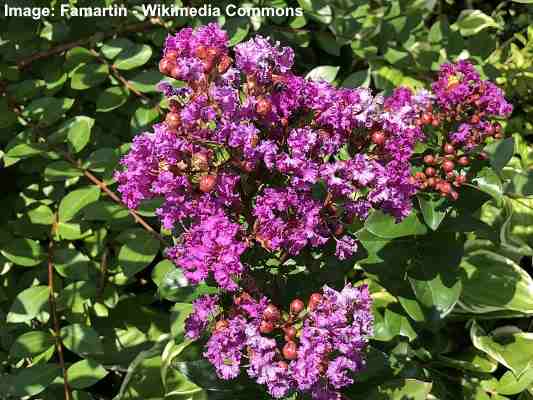
Lagerstroemia’ Purple Magic’ flowers
Lagerstroemia’ Early Bird’: This small crape myrtle shrub can grow as a small tree, producing clusters of bright purple flowers. As its name suggests, it’s one of the earliest crape myrtle shrubs to bloom in the season. It grows 5 to 6 ft. (1.5 – 1.8 m) tall and 4 ft. (1.2 m) wide.
Lagerstroemia’ Infinitini Purple’: This compact crape myrtle cultivar blooms with abundant clusters of deep purple flowers. The large clusters have crinkly flowers that look like crepe paper. This small shrub is well-suited for smaller gardens, borders, or foundation planting. It grows 3 to 5 ft. (1 – 1.5 m) tall and wide.
Lagerstroemia’ Infinitini Orchid’: Ideal for landscaping in tight spaces or compact gardens, the stunning shrub has brilliant lavender or crinkly purple flowers. The delightful clusters bloom from summer through fall, adding a splash of vibrant color to gardens, borders, or containers. It grows 2 to 4 ft. (0.6 – 1.2 m) tall and wide.
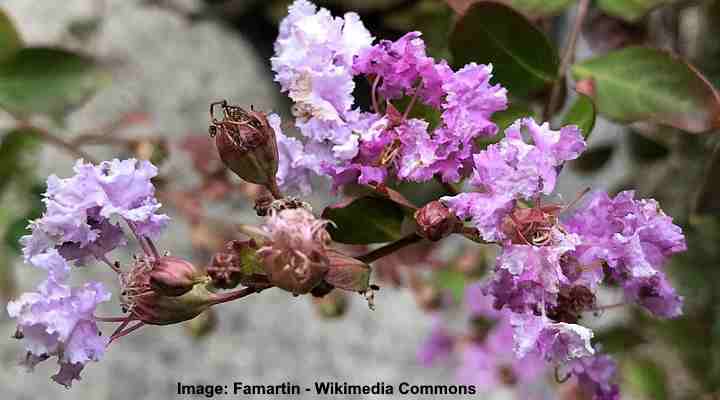
Lagerstroemia’ Infinitini Orchid’
Catawba Crape Myrtle (Lagerstroemia indica ‘Catawba’) – The ‘Catawba’ crape myrtle is a beautiful small crape myrtle tree or medium-large shrub that has purple flowers. This crape myrtle cultivar blooms in late summer. Its purple flower clusters contrast with the glossy green, dense foliage. ‘Catawba’ crape myrtle trees grow between 10 and 15 ft. (3 – 4.5 m) tall with a similar-sized spread.
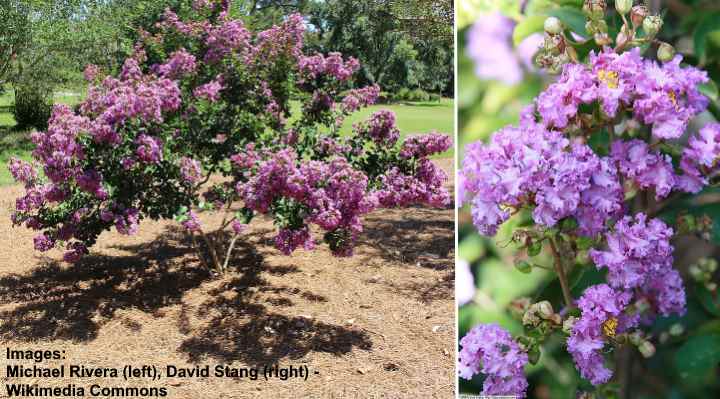
Catawba crape myrtle
Pride of India (Lagerstroemia speciosa)
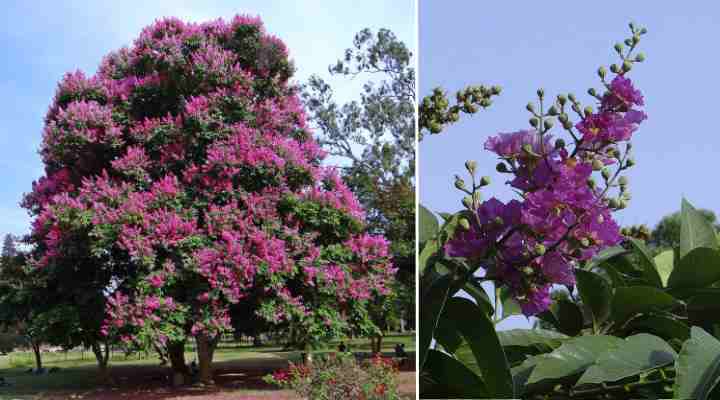
The Pride of India is a medium-sized deciduous tree known for its stunning clusters of showy, crinkled magenta-purple flowers. Also called giant crape myrtle or Queen’s crape myrtle, a profusion of flowers bloom in late spring and early summer. The tree’s smooth, peeling bark and attractive oval leaves add to its ornamental appeal.
Pride of India trees are popular ornamental trees in parks, gardens, and along streets. Their medium size and attractive, wide-spreading canopy make them useful shade trees. The tree’s vibrantly-colored erect panicles (flower clusters) and attractive foliage make it a popular choice for adding color and beauty to landscapes.
Mature Size: 40 to 50 ft. (12 – 15 m) tall and wide
USDA Hardiness Zones: 10 and 11
Sun: Full sun
Blue Chinese Wisteria Tree (Wisteria sinensis)

The flowering blue Chinese wisteria tree is a stunning ornamental tree that can be identified by its cascading clusters of fragrant, icy lavender-blue flowers. The flowers bloom from dark purple buds in spring. They blossom into long, pendulous clusters, creating a dramatic display as they hang from branches. The tree’s arching branches create a spectacular umbrella-like canopy.
The glossy, small, dark green leaves provide lush foliage in summer. In the fall, they turn an eye-catching golden yellow. For best blooming and foliage, grow blue Chinese wisteria trees in full sun and well-drained soil.
The wisteria tree’s elegant, sweetly scented flowers and graceful form create a lavish floral display. It’s an ideal purple-flowering tree to create a dramatic focal point in a small to medium-sized yard.
Mature Size: 10 to 15 ft. (3 – 15 m) tall and wide
USDA Hardiness Zones: 5 to 9
Sun: Full sun or light shade
Empress Tree (Paulownia tomentosa)
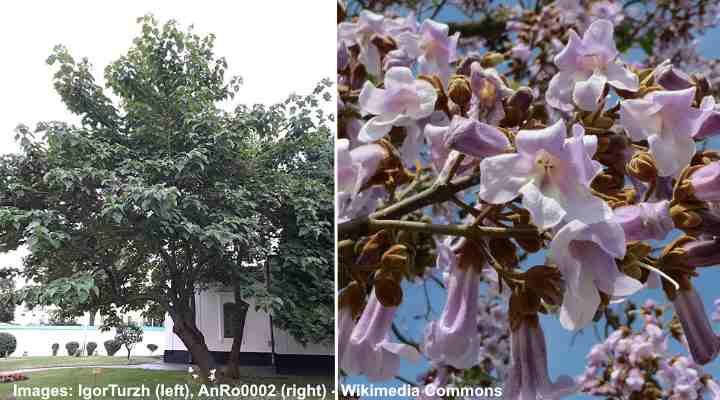
The flowering Empress tree is a fast-growing deciduous tree identified by its tube-like pale violet, vanilla-scented flowers. The edible light purple or lavender flowers bloom in showy clusters throughout spring. The funnel-shaped flowers emerge on bare branches before the large heart-shaped leaves appear. The lavender flowers cover the tree’s branches, creating a stunning display.
The Empress tree has velvety leaves with a fuzzy texture on both sides. The heart-shaped leaves can grow up to 12” (30 cm) in diameter. The tree’s dense spreading canopy offers shade during summer. In the fall, the leaves turn yellow before dropping. Then, long woody seed capsules are visible on the tree.
The Empress tree has tremendous ornamental value thanks to its fast growth rate, lush foliage, and fragrant flowers. You can plant it as a specimen tree, in groupings, or a shrub-like hedge. It thrives in most soil types with constant moisture and good drainage.
It’s good to note that this non-native tree can become invasive in some parts of North America.
Mature Size: 40 to 60 ft. (12 – 18 m) tall and wide
USDA Hardiness Zones: 5 to 9
Sun: Full sun
Silk Floss Tree (Ceiba speciosa)
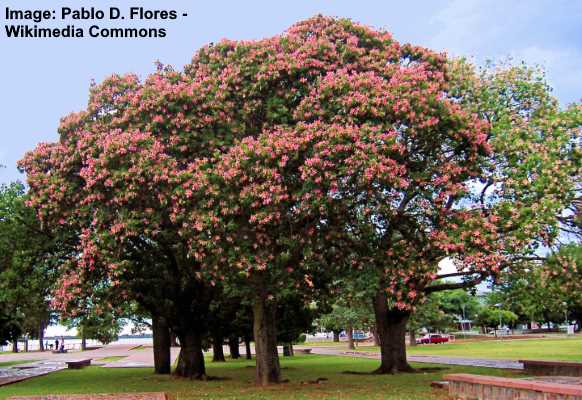
The silk floss tree is a majestic, thorny tree with large, striking pink-purple star-shaped flowers. Blooming during summer, the large five-petaled flowers measure 4” to 6” (10 – 15 cm) across. The flowers are followed by large, woody seed pods containing seeds covered in silky cotton-like fibers.

Ceiba speciosa flowers and leaves
Other identifying features of the purple flowering silk floss tree include its trunk covered in large, sharp spines, bright-green palmate leaves, and an attractive yellow fall foliage color. For the best results in a landscape, grow the silk floss tree in moist, well-drained soil where it gets at least six hours of sunshine daily.
Silk floss trees are a stunning addition to any landscape. Its wide-spreading, dense canopy makes it a great shade tree. Its rounded crown and clusters of showy purple flowers make it an excellent specimen tree. Additionally, the tree is drought-tolerant and can withstand periods of dry weather.
Unfortunately, their thorny trunks mean the purple-flowering trees are not suitable for every garden.
Mature Size: 40 to 60 ft. (12 – 18 m) tall and 20 to 30 ft. (6 – 9 m) wide
USDA Hardiness Zones: 9 to 11
Sun: Full sun
Purple Flowering Crabapple Trees (Malus spp.)
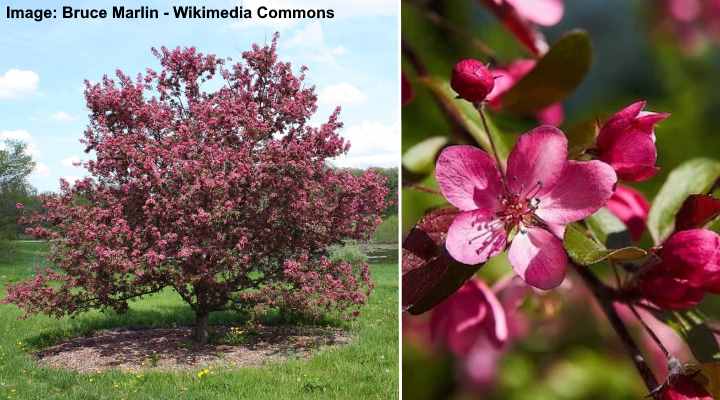
Purple Prince crabapple (Malus ‘Purple Prince’)
Purple flowering crabapple trees are a group of small to medium-sized fruiting trees, some of which have stunning purple flowers. These flowering trees bloom in early spring, covering the branches and emitting sweet scents. Some of the most spectacular purple-flowering crabapple trees have dark purple leaves. They also produce small cherry-like apples.
Purple-flowering crabapple trees are versatile and can be used in various landscape settings. You can plant them as specimen trees, group plantings, or grow in rows as a hedge. These trees are generally hardy and can tolerate a range of soil types. Additionally, they brighten fall landscapes with red, purple, and yellow shades.
Here are two varieties of small crabapple trees with purple flowers:
Malus’ Kelsey’: This hardy crabapple blooms in spring with abundant semi-double or double purple-red flowers. Its foliage emerges red in spring, turns bronze-green, and becomes orange and yellow in the fall. The small upright crabapple with its rounded canopy measures 15 to 18 ft. (4.5 – 5.4 m) tall and wide.
Malus’ Purple Prince’: This small to medium-sized deciduous fruit tree has a rounded or slightly spreading crown and a dense, compact habit. The tree’s identifying feature is its deep purple to pink flowers and purple foliage. Thriving in full sun and well-drained soil, the crabapple grows 18 to 20 ft. (5.4 – 6 m) tall and wide.
Judas Tree (Cercis siliquastrum)

The Judas tree belongs to the redbud group of ornamental trees. It is characterized by its clusters of vibrant purplish-rose flowers. The pea-like flowers bloom in early spring, covering the spreading, rounded crown. Heart-shaped leaves emerge bronze-red in late spring and turn yellow in the fall. Additionally, reddish-purple seed pods dangle from branches and persist through winter.
The Judas tree’s attractive shape, foliage, and showy flowers make it popular for ornamental planting. Judas trees prefer well-drained soil and can tolerate a range of soil types in sunny landscapes.
Landscaping uses for the Judas tree include a specimen tree, a flowering tree for borders, or a shade tree for patios. Native to the Mediterranean region, the Judas tree has plenty of aesthetic appeal thanks to its striking purple flowers and unique seed pods.
Mature Size: 15 to 25 ft. (4.5 – 7.5 m) tall and wide
USDA Hardiness Zones: 6 to 9
Sun: Full sun or partial shade
Discover many other types of flowering trees in a variety of colors.
Related articles:
